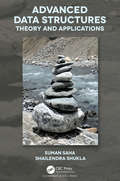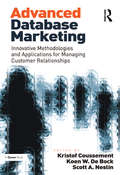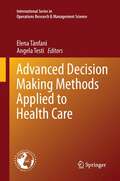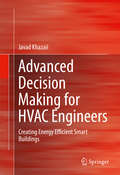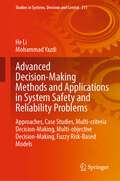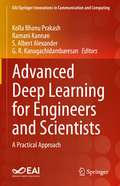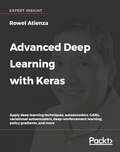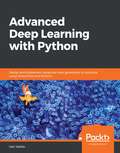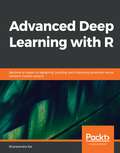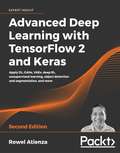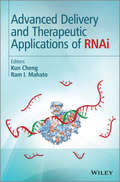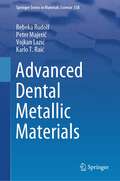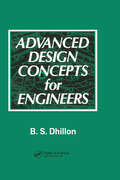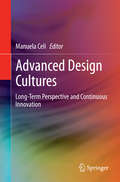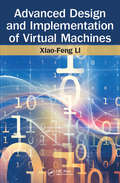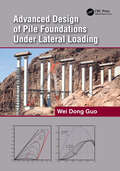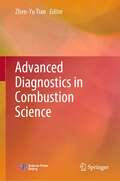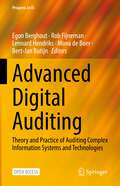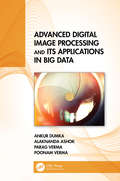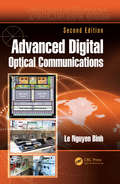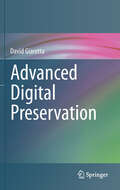- Table View
- List View
Advanced Data Structures: Theory and Applications
by Suman Saha Shailendra ShuklaAdvanced data structures is a core course in Computer Science which most graduate program in Computer Science, Computer Science and Engineering, and other allied engineering disciplines, offer during the first year or first semester of the curriculum. The objective of this course is to enable students to have the much-needed foundation for advanced technical skill, leading to better problem-solving in their respective disciplines. Although the course is running in almost all the technical universities for decades, major changes in the syllabus have been observed due to the recent paradigm shift of computation which is more focused on huge data and internet-based technologies. Majority of the institute has been redefined their course content of advanced data structure to fit the current need and course material heavily relies on research papers because of nonavailability of the redefined text book advanced data structure. To the best of our knowledge well-known textbook on advanced data structure provides only partial coverage of the syllabus. The book offers comprehensive coverage of the most essential topics, including: Part I details advancements on basic data structures, viz., cuckoo hashing, skip list, tango tree and Fibonacci heaps and index files. Part II details data structures of different evolving data domains like special data structures, temporal data structures, external memory data structures, distributed and streaming data structures. Part III elucidates the applications of these data structures on different areas of computer science viz, network, www, DBMS, cryptography, graphics to name a few. The concepts and techniques behind each data structure and their applications have been explained. Every chapter includes a variety of Illustrative Problems pertaining to the data structure(s) detailed, a summary of the technical content of the chapter and a list of Review Questions, to reinforce the comprehension of the concepts. The book could be used both as an introductory or an advanced-level textbook for the advanced undergraduate, graduate and research programmes which offer advanced data structures as a core or an elective course. While the book is primarily meant to serve as a course material for use in the classroom, it could be used as a starting point for the beginner researcher of a specific domain.
Advanced Database Marketing: Innovative Methodologies and Applications for Managing Customer Relationships
by Koen W. BockWhile the definition of database marketing hasn’t changed, its meaning has become more vivid, versatile and exciting than ever before. Advanced Database Marketing provides a state-of-the-art guide to the methods and applications that define this new era in database marketing, including advances in areas such as text mining, recommendation systems, internet marketing, and dynamic customer management. An impressive list of contributors including many of the thought-leaders in database marketing from across the world bring together chapters that combine the best academic research and business applications. The result is a definitive guide and reference for marketing and brand analysts, masters students, teachers and researchers in marketing analytics. The proliferation of marketing platforms and channels and the complexity of customer interactions create an urgent need for a multidisciplinary and analytical toolkit. Advanced Database Marketing is a resource to enable marketers to achieve insights and increased financial performance; to provide them with the capability to implement and evaluate approaches to marketing that will meet, in equal measure, the changing needs of customers and the businesses that serve them.
Advanced Decision Making Methods Applied to Health Care (International Series in Operations Research & Management Science #173)
by Angela Testi Elena TanfaniThe most difficult part of making decisions in the health care field on all levels (national, regional, institutional, patient) is linked to the very complexity of the system itself, to the intrinsic uncertainty involved and its dynamic nature. This requires not only the ability to analyze and interpret a large amount of information but also arrange it so that it becomes a cognitive base for appropriate decision-making. Moreover, decisions in the health care field are subjected to many challenges and constraints: fast change and uncertain outcomes, aging population, increasing citizen expectations, equity considerations and limited resources. Operations research, statistical and economic-related quantitative methods supply these decisions making tools and methodology. The contributed book presents a collection of applications to concrete situations detailing the problem area, the methodology employed, the implementation and results. Each topic addressed in the book will be structured in such a way that an interdisciplinary and wide audience will be able to use the materials presented. As an example the book chapters will address health policies issues, planning health services, epidemiology and disease modelling, home-care modelling, logistics in health care, capacity planning, quality and appropriateness.
Advanced Decision Making for HVAC Engineers: Creating Energy Efficient Smart Buildings
by Javad KhazaiiThis book focuses on some of the most energy-consuming HVAC systems; illuminating huge opportunities for energy savings in buildings that operate with these systems. The main discussion is on, cutting-edge decision making approaches, and algorithms in: decision making under uncertainty, genetic algorithms, fuzzy logic, artificial neural networks, agent based modeling, and game theory. These methods are applied to HVAC systems, in order to help designers select the best options among the many available pathways for designing and the building of HVAC systems and applications. The discussion further evolves to depict how the buildings of the future can incorporate these advanced decision-making algorithms to become autonomous and truly 'smart'.
Advanced Decision-Making Methods and Applications in System Safety and Reliability Problems: Approaches, Case Studies, Multi-criteria Decision-Making, Multi-objective Decision-Making, Fuzzy Risk-Based Models (Studies in Systems, Decision and Control #211)
by He Li Mohammad YazdiThis book reviews and presents several approaches to advanced decision-making models for safety and risk assessment. Each introduced model provides case studies indicating a high level of efficiency, robustness, and applicability, which allow readers to utilize them in their understudy risk-based assessment applications. The book begins by introducing a novel dynamic DEMATEL for improving safety management systems. It then progresses logically, dedicating a chapter to each approach, including advanced FMEA with probabilistic linguistic preference relations, Bayesian Network approach and interval type-2 fuzzy set, advanced TOPSIS with spherical fuzzy set, and advanced BWM with neutrosophic fuzzy set and evidence theory. This book will be of interest to professionals and researchers working in the field of system safety and reliability and postgraduate and undergraduate students studying applications of decision-making tools and expert systems.
Advanced Deep Learning for Engineers and Scientists: A Practical Approach (EAI/Springer Innovations in Communication and Computing)
by Ramani Kannan G. R. Kanagachidambaresan S. Albert Alexander Kolla Bhanu PrakashThis book provides a complete illustration of deep learning concepts with case-studies and practical examples useful for real time applications. This book introduces a broad range of topics in deep learning. The authors start with the fundamentals, architectures, tools needed for effective implementation for scientists. They then present technical exposure towards deep learning using Keras, Tensorflow, Pytorch and Python. They proceed with advanced concepts with hands-on sessions for deep learning. Engineers, scientists, researches looking for a practical approach to deep learning will enjoy this book.Presents practical basics to advanced concepts in deep learning and how to apply them through various projects;Discusses topics such as deep learning in smart grids and renewable energy & sustainable development;Explains how to implement advanced techniques in deep learning using Pytorch, Keras, Python programming.
Advanced Deep Learning with Keras: Apply deep learning techniques, autoencoders, GANs, variational autoencoders, deep reinforcement learning, policy gradients, and more
by Rowel AtienzaUnderstanding and coding advanced deep learning algorithms with the most intuitive deep learning library in existenceKey FeaturesExplore the most advanced deep learning techniques that drive modern AI resultsImplement deep neural networks, autoencoders, GANs, VAEs, and deep reinforcement learningA wide study of GANs, including Improved GANs, Cross-Domain GANs, and Disentangled Representation GANsBook DescriptionRecent developments in deep learning, including Generative Adversarial Networks (GANs), Variational Autoencoders (VAEs), and Deep Reinforcement Learning (DRL) are creating impressive AI results in our news headlines - such as AlphaGo Zero beating world chess champions, and generative AI that can create art paintings that sell for over $400k because they are so human-like. Advanced Deep Learning with Keras is a comprehensive guide to the advanced deep learning techniques available today, so you can create your own cutting-edge AI. Using Keras as an open-source deep learning library, you'll find hands-on projects throughout that show you how to create more effective AI with the latest techniques. The journey begins with an overview of MLPs, CNNs, and RNNs, which are the building blocks for the more advanced techniques in the book. You’ll learn how to implement deep learning models with Keras and TensorFlow 1.x, and move forwards to advanced techniques, as you explore deep neural network architectures, including ResNet and DenseNet, and how to create autoencoders. You then learn all about GANs, and how they can open new levels of AI performance. Next, you’ll get up to speed with how VAEs are implemented, and you’ll see how GANs and VAEs have the generative power to synthesize data that can be extremely convincing to humans - a major stride forward for modern AI. To complete this set of advanced techniques, you'll learn how to implement DRL such as Deep Q-Learning and Policy Gradient Methods, which are critical to many modern results in AI.What you will learnCutting-edge techniques in human-like AI performanceImplement advanced deep learning models using KerasThe building blocks for advanced techniques - MLPs, CNNs, and RNNsDeep neural networks – ResNet and DenseNetAutoencoders and Variational Autoencoders (VAEs)Generative Adversarial Networks (GANs) and creative AI techniquesDisentangled Representation GANs, and Cross-Domain GANsDeep reinforcement learning methods and implementationProduce industry-standard applications using OpenAI GymDeep Q-Learning and Policy Gradient MethodsWho this book is forSome fluency with Python is assumed. As an advanced book, you'll be familiar with some machine learning approaches, and some practical experience with DL will be helpful. Knowledge of Keras or TensorFlow 1.x is not required but would be helpful.
Advanced Deep Learning with Python: Design and implement advanced next-generation AI solutions using TensorFlow and PyTorch
by Ivan VasilevGain expertise in advanced deep learning domains such as neural networks, meta-learning, graph neural networks, and memory augmented neural networks using the Python ecosystem Key Features Get to grips with building faster and more robust deep learning architectures Investigate and train convolutional neural network (CNN) models with GPU-accelerated libraries such as TensorFlow and PyTorch Apply deep neural networks (DNNs) to computer vision problems, NLP, and GANs Book Description In order to build robust deep learning systems, you'll need to understand everything from how neural networks work to training CNN models. In this book, you'll discover newly developed deep learning models, methodologies used in the domain, and their implementation based on areas of application. You'll start by understanding the building blocks and the math behind neural networks, and then move on to CNNs and their advanced applications in computer vision. You'll also learn to apply the most popular CNN architectures in object detection and image segmentation. Further on, you'll focus on variational autoencoders and GANs. You'll then use neural networks to extract sophisticated vector representations of words, before going on to cover various types of recurrent networks, such as LSTM and GRU. You'll even explore the attention mechanism to process sequential data without the help of recurrent neural networks (RNNs). Later, you'll use graph neural networks for processing structured data, along with covering meta-learning, which allows you to train neural networks with fewer training samples. Finally, you'll understand how to apply deep learning to autonomous vehicles. By the end of this book, you'll have mastered key deep learning concepts and the different applications of deep learning models in the real world. What you will learn Cover advanced and state-of-the-art neural network architectures Understand the theory and math behind neural networks Train DNNs and apply them to modern deep learning problems Use CNNs for object detection and image segmentation Implement generative adversarial networks (GANs) and variational autoencoders to generate new images Solve natural language processing (NLP) tasks, such as machine translation, using sequence-to-sequence models Understand DL techniques, such as meta-learning and graph neural networks Who this book is for This book is for data scientists, deep learning engineers and researchers, and AI developers who want to further their knowledge of deep learning and build innovative and unique deep learning projects. Anyone looking to get to grips with advanced use cases and methodologies adopted in the deep learning domain using real-world examples will also find this book useful. Basic understanding of deep learning concepts and working knowledge of the Python programming language is assumed.
Advanced Deep Learning with R: Become an expert at designing, building, and improving advanced neural network models using R
by Bharatendra RaiThis book is for data scientists, machine learning practitioners, deep learning researchers and AI enthusiasts who want to extend their skills and knowledge to implement deep learning techniques and algorithms using the power of R. With this book, you will learn to build advanced neural networks using extensive libraries from R ecosystem. Strong understanding of machine learning and working knowledge of R programming language is expected.
Advanced Deep Learning with TensorFlow 2 and Keras: Apply DL, GANs, VAEs, deep RL, unsupervised learning, object detection and segmentation, and more, 2nd Edition
by Rowel AtienzaUpdated and revised second edition of the bestselling guide to advanced deep learning with TensorFlow 2 and Keras Key Features Explore the most advanced deep learning techniques that drive modern AI results New coverage of unsupervised deep learning using mutual information, object detection, and semantic segmentation Completely updated for TensorFlow 2.x Book Description Advanced Deep Learning with TensorFlow 2 and Keras, Second Edition is a completely updated edition of the bestselling guide to the advanced deep learning techniques available today. Revised for TensorFlow 2.x, this edition introduces you to the practical side of deep learning with new chapters on unsupervised learning using mutual information, object detection (SSD), and semantic segmentation (FCN and PSPNet), further allowing you to create your own cutting-edge AI projects. Using Keras as an open-source deep learning library, the book features hands-on projects that show you how to create more effective AI with the most up-to-date techniques. Starting with an overview of multi-layer perceptrons (MLPs), convolutional neural networks (CNNs), and recurrent neural networks (RNNs), the book then introduces more cutting-edge techniques as you explore deep neural network architectures, including ResNet and DenseNet, and how to create autoencoders. You will then learn about GANs, and how they can unlock new levels of AI performance. Next, you'll discover how a variational autoencoder (VAE) is implemented, and how GANs and VAEs have the generative power to synthesize data that can be extremely convincing to humans. You'll also learn to implement DRL such as Deep Q-Learning and Policy Gradient Methods, which are critical to many modern results in AI. What you will learn Use mutual information maximization techniques to perform unsupervised learning Use segmentation to identify the pixel-wise class of each object in an image Identify both the bounding box and class of objects in an image using object detection Learn the building blocks for advanced techniques - MLPss, CNN, and RNNs Understand deep neural networks - including ResNet and DenseNet Understand and build autoregressive models – autoencoders, VAEs, and GANs Discover and implement deep reinforcement learning methods Who this book is for This is not an introductory book, so fluency with Python is required. The reader should also be familiar with some machine learning approaches, and practical experience with DL will also be helpful. Knowledge of Keras or TensorFlow 2.0 is not required but is recommended.
Advanced Delivery and Therapeutic Applications of RNAi
by Ram I. Mahato Kun ChengRNA interference (RNAi) is a process in living cells whereby small double stranded RNA interferes with the expression of specific genes with complementary nucleotide sequence. Like many nucleic acid-based therapies, RNAi has great potential in treating various life-threatening diseases. However, the poor stability and cellular uptake of RNAi molecules remain considerable barriers to their efficient delivery which is paramount to a successful therapy. This book provides a comprehensive introduction to RNAi delivery, then goes on to discuss different delivery strategies, and concludes with current applications in various diseases. It covers:Mechanisms, Barriers, and Analysis of RNAi DeliveryNonclinical Safety Assessments and Clinical Pharmacokinetics: A Regulatory PerspectiveBioconjugation of siRNA for Site Specifi c DeliveryNanoscale Delivery Systems for RNAiEnvironmentally-Responsive Delivery Systems for RNAiLight-sensitive RNAiViral-Mediated Delivery of shRNA and miRNARNAi applications in Cancer Therapy, Liver Diseases, Hepatitis B, and Ocular DiseasemiRNA as therapeutic agents and targetsAdvanced Delivery and Therapeutic Applications of RNAi combines the essential aspects of developing RNAi therapeutics from bench to clinic, and is invaluable for researchers working on RNAi, drug discovery and delivery, biomedical engineering, biomaterials, molecular biology, and biotechnology.
Advanced Dental Metallic Materials (Springer Series in Materials Science #338)
by Rebeka Rudolf Vojkan Lazić Peter Majerič Karlo T. RaićThis book delivers a broad and concise look at advanced metallic materials used for dental applications. Due to their excellent mechanical and biological properties, the use of metallic materials in dentistry has continued since time immemorial. In that sense, this book aims to bring the readers closer to the specific purpose of dental metallic materials meeting specific criteria and materials properties such as biocompatibility, non-toxicity, resistance to corrosion, long-term durability, appropriate strength and toughness, as well as corresponding values of modulus of elasticity. Following a comprehensive introduction to the field, the book discusses topical issues such as the long-term stability of dental titanium implants, processing of cobalt-chrome dental alloys, emerging gold dental alloys, and novel nanofoils used for dental joining. Featuring numerous illustrative examples of experimental outcomes, this book is an ideal resource for materials scientists and metallurgists working on advanced alloys for dental applications.
Advanced Design Concepts for Engineers
by B.S. DhillonThis book provides the design engineer with concise information on the most important advanced methods that have emerged in recent years for the design of structures, products and components. While these methods have been discussed in the professional literature, this is the first full presentation of their key principles and features in a single c
Advanced Design Cultures: Long-Term Perspective and Continuous Innovation
by Manuela CeliThis book describes new thinking and practice in Advanced Design (ADD) - design that is not merely highly developed but anticipates the future by envisioning novel products and processes. The focus is especially on the front end of innovation and the search for solutions in complex pioneering processes using design-related tools and practices. The book opens by describing these tools, the approaches that characterize ADD and its historical dimension. Specific fields in which ADD has flourished are then examined, exploring the dynamics between research and design. The coverage ranges from transportation, lighting and electrical appliances through to business networks, technology parks and the development of ground-breaking materials. Advance Design is the name of the research group at the Politecnico di Milano (Italy's largest technical university) of which the authors are members. It was chosen to reflect both the "advanced", tangible dimension of design in terms of modern product development, materials and technologies and an orientation toward radical innovation through user involvement and imagination.
Advanced Design and Implementation of Virtual Machines
by Xiao-Feng LiAlong with the increasingly important runtime engines pervasive in our daily-life computing, there is a strong demand from the software community for a solid presentation on the design and implementation of modern virtual machines, including the Java virtual machine, JavaScript engine and Android execution engine. The community expects to see not only formal algorithm description, but also pragmatic code snippets; to understand not only research topics, but also engineering solutions. This book meets these demands by providing a unique description that combines high level design with low level implementations and academic advanced topics with commercial solutions. This book takes a holistic approach to the design of VM architecture, with contents organized into a consistent framework, introducing topics and algorithms in an easily understood step by step process. It focuses on the critical aspects of VM design, which are often overlooked in other works, such as runtime helpers, stack unwinding and native interface. The algorithms are fully illustrated in figures and implemented in easy to digest code snippets, making the abstract concepts tangible and programmable for system software developers.
Advanced Design of Pile Foundations Under Lateral Loading
by Wei Dong GuoThis book presents models that capture the nonlinear response of piles subjected to lateral forces. Utilising a consistent approach encompassing new mathematical models, it offers solutions presented as closed-form expressions and underpinned by the same set of 3-5 measurable soil-input parameters. These focus on nonlinear response of mono piles, anchored piles, pile groups, and torsional piles, as well as passive piles subjected to soil movement induced in shearing, sliding slopes or excavation, and earthquake shaking. The models can also be used for pipelines and similar beam structures. Solutions are provided in the form of design charts, with each parameter obtained using available test data and illustrated with real-world cases. The models reveal, for the first time, the mysterious mechanisms of amplification resulting from back-rotation, which have incurred the collapse of structures such as the Showa Bridge and Nicoll Highway, as well as the distortion of piles during earthquakes. Advanced Design of Pile Foundations Under Lateral Loading is ideal for practicing foundation engineers and students at graduate level. Wei Dong Guo is co-founder of Hans Innovation Group and former Associate Professor at the University of Wollongong, Australia. He is a Chartered Professional Engineer and is a Fellow of Engineers Australia by whom he was awarded the 2012 Warren Medal.
Advanced Design: Universal Principles for All Disciplines
by John ReisThis book is about design. Everybody does design, from artists to engineers, from interior designers to industrial designers. We design our days and we design our lives. This book presents the three universal activities that everyone uses, no matter who they are or what they do. These three activities are 1.) clarify an ambiguous project, 2.) generate ideas, and 3.) select one idea for implementation. This book also presents how the psychology of design impacts our effectiveness with each of these three activities, from creativity through decision making, intuition through analysis, and cognitive enhancement through design biases. Although the examples provided in this book primarily target the diverse disciplines of art (painting) and engineering, they can be easily understood and adapted by designers in any discipline.This book helps advanced design students and working professionals in any discipline to understand why and when the basic design principles they were taught work or do not work and, as a result, improve their design effectiveness.
Advanced Detectors for Nuclear, High Energy and Astroparticle Physics: Proceedings Of Adnheap 2017 (Springer Proceedings In Physics #201)
by Saikat Biswas Supriya Das Sanjay Kumar GhoshThe book presents high-quality papers presented at a national conference on ‘Advanced Detectors for Nuclear, High Energy and Astroparticle Physics’. The conference was organized to commemorate 100 years of Bose Institute. The book is based on the theme of the conference and provides a clear picture of basics and advancement of detectors for nuclear physics, high-energy physics and astroparticle physics together. The topics covered in the book include detectors for accelerator-based high energy physics; detectors for non-accelerator particle physics; nuclear physics detectors; detection techniques in astroparticle physics and dark matter; and applications and simulations. The book will be a good reference for researchers and industrial personnel working in the area of nuclear and astroparticle physics.
Advanced Diagnostics in Combustion Science
by Zhen-Yu TianThis textbook, supported by the Textbook Publishing Center of University of Chinese Academy of Sciences, provides a fundamental introduction to advanced diagnostics techniques for graduate students majoring in combustion science, chemistry, and chemical engineering-related subjects. The textbook provides an overview with respect to the spectroscopic methods in advanced diagnostics techniques such as gas chromatography/mass spectrometry, thermochemical analysis, Raman scattering, and nuclear magnetic resonance. It then describes the comprehensive basic theory, equipment structure, and testing methods of diagnostic techniques and summarizes the analysis methods commonly used in combustion chemical reaction processes. This can provide graduate students with important guidance and comprehensive understanding of diagnostics techniques before performing physics and chemistry experiments. In addition, it provides an introduction into using common mathematical and graphics packages for students to acquire and practice the tools to comply with international standards. The textbook is concise and illustrative and includes hot issues and current progress of diagnostics. In addition, exercises and questions are included at the end of each chapter for students to practice and gain hands-on experience. Given its scope, the textbook is of great benefit to graduate students in combustion chemistry and engineering and other related areas such as environmental science, optical engineering, and thermal science and is also beneficial for researchers with interdisciplinary backgrounds.
Advanced Differential Quadrature Methods (Chapman & Hall/CRC Applied Mathematics & Nonlinear Science)
by Zhi Zong Yingyan ZhangModern Tools to Perform Numerical DifferentiationThe original direct differential quadrature (DQ) method has been known to fail for problems with strong nonlinearity and material discontinuity as well as for problems involving singularity, irregularity, and multiple scales. But now researchers in applied mathematics, computational mechanics, and en
Advanced Digital Auditing: Theory and Practice of Auditing Complex Information Systems and Technologies (Progress in IS)
by Egon Berghout Rob Fijneman Lennard Hendriks Mona De Boer Bert-Jan ButijnThis open access book discusses the most modern approach to auditing complex digital systems and technologies. It combines proven auditing approaches, advanced programming techniques and complex application areas, and covers the latest findings on theory and practice in this rapidly developing field. Especially for those who want to learn more about novel approaches to testing complex information systems and related technologies, such as blockchain and self-learning systems, the book will be a valuable resource. It is aimed at students and practitioners who are interested in contemporary technology and managerial implications.
Advanced Digital Image Processing and Its Applications in Big Data
by Ankur Dumka Alaknanda Ashok Parag Verma Poonam VermaThis book covers the technology of digital image processing in various fields with big data and their applications. Readers will understand various technologies and strategies used in digital image processing as well as handling big data, using machine-learning techniques. This book will help to improve the skills of students and researchers in such fields as engineering, agriculture, and medical imaging. There is a need to be able to understand and analyse the latest developments of digital image technology. As such, this book will cover: · Applications such as biomedical science and biometric image processing, content-based image retrieval, remote sensing, pattern recognition, shape and texture analysis · New concepts in color interpolation to produce the full color from the sub-pattern bare pattern color prevalent in today's digital cameras and other imaging devices · Image compression standards that are needed to serve diverse applications · Applications of remote sensing, medical science, traffic management, education, innovation, and analysis in agricultural design and image processing · Both soft and hard computing approaches at great length in relation to major image processing tasks · The direction and development of current and future research in many areas of image processing · A comprehensive bibliography for additional research (integrated within the framework of the book) This book focuses not only on theoretical and practical knowledge in the field but also on the traditional and latest tools and techniques adopted in image processing and data science. It also provides an indispensable guide to a wide range of basic and advanced techniques in the fields of image processing and data science.
Advanced Digital Optical Communications (Optics and Photonics)
by Le BinhThis second edition of Digital Optical Communications provides a comprehensive treatment of the modern aspects of coherent homodyne and self-coherent reception techniques using algorithms incorporated in digital signal processing (DSP) systems and DSP-based transmitters to overcome several linear and nonlinear transmission impairments and frequency mismatching between the local oscillator and the carrier, as well as clock recovery and cycle slips. These modern transmission systems have emerged as the core technology for Tera-bits per second (bps) and Peta-bps optical Internet for the near future. Featuring extensive updates to all existing chapters, Advanced Digital Optical Communications, Second Edition: Contains new chapters on optical fiber structures and propagation, optical coherent receivers, DSP equalizer algorithms, and high-order spectral DSP receivers Examines theoretical foundations, practical case studies, and MATLAB® and Simulink® models for simulation transmissions Includes new end-of-chapter practice problems and useful appendices to supplement technical information Downloadable content available with qualifying course adoption Advanced Digital Optical Communications, Second Edition supplies a fundamental understanding of digital communication applications in optical communication technologies, emphasizing operation principles versus heavy mathematical analysis. It is an ideal text for aspiring engineers and a valuable professional reference for those involved in optics, telecommunications, electronics, photonics, and digital signal processing.
Advanced Digital Preservation
by David GiarettaThere is growing recognition of the need to address the fragility of digital information, on which our society heavily depends for smooth operation in all aspects of daily life. This has been discussed in many books and articles on digital preservation, so why is there a need for yet one more? Because, for the most part, those other publications focus on documents, images and webpages - objects that are normally rendered to be simply displayed by software to a human viewer. Yet there are clearly many more types of digital objects that may need to be preserved, such as databases, scientific data and software itself. David Giaretta, Director of the Alliance for Permanent Access, and his contributors explain why the tools and techniques used for preserving rendered objects are inadequate for all these other types of digital objects, and they provide the concepts, techniques and tools that are needed. The book is structured in three parts. The first part is on theory, i.e., the concepts and techniques that are essential for preserving digitally encoded information. The second part then shows practice, i.e., the use and validation of these tools and techniques. Finally, the third part concludes by addressing how to judge whether money is being well spent, in terms of effectiveness and cost sharing. Various examples of digital objects from many sources are used to explain the tools and techniques presented. The presentation style mainly aims at practitioners in libraries, archives and industry who are either directly responsible for preservation or who need to prepare for audits of their archives. Researchers in digital preservation and developers of preservation tools and techniques will also find valuable practical information here. Researchers creating digitally encoded information of all kinds will also need to be aware of these topics so that they can help to ensure that their data is usable and can be valued by others now and in the future. To further assist the reader, the book is supported by many hours of videos and presentations from the CASPAR project and by a set of open source software.
Advanced Digital Signal Processing of Seismic Data
by Wail A. MousaSeismic data must be interpreted using digital signal processing techniques in order to create accurate representations of petroleum reservoirs and the interior structure of the Earth. This book provides an advanced overview of digital signal processing (DSP) and its applications to exploration seismology using real-world examples. The book begins by introducing seismic theory, describing how to identify seismic events in terms of signals and noise, and how to convert seismic data into the language of DSP. Deterministic DSP is then covered, together with non-conventional sampling techniques. The final part covers statistical seismic signal processing via Wiener optimum filtering, deconvolution, linear-prediction filtering and seismic wavelet processing. With over sixty end-of-chapter exercises, seismic data sets and data processing MATLAB codes included, this is an ideal resource for electrical engineering students unfamiliar with seismic data, and for Earth Scientists and petroleum professionals interested in DSP techniques.
